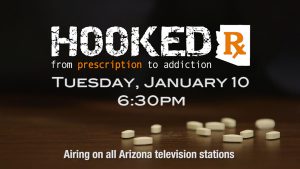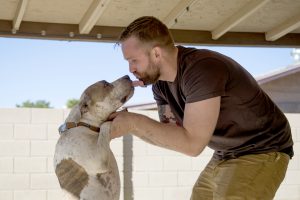- Slug: BC-CNS-Opioids Deaths,1,400
- Photos available (thumbnails, captions below)
- EDS: PLEASE RUN THE HOOKED PROMO PHOTO (below) OR THIS BOX WITH THIS STORY IF YOU PLAN TO PUBLISH PRIOR TO JAN. 10: Watch “Hooked Rx: From Prescription to Addiction,” a 30-minute commercial-free investigative report airing at 6:30 p.m. on Jan. 10 on 30 broadcast TV stations in Phoenix, Tucson and Yuma and 97 of the state’s radio stations. For the full report, go to hookedrx.com.
By RYAN SANTISTEVAN and BEN MOFFAT
Cronkite News
MESA – John Koch knows about dying. He said he’s flatlined three times. But with each overdose, paramedics and doctors brought him back.
“There’s no light when you die,” he said. “It was just darkness. … I’m an addict. Death didn’t scare me as long as I got my fix.”
When Koch was 14 years old, he found his opioid addiction first in Vicodin pills from a friend, then through fentanyl suckers.
“I loved it,” he said. “Shortly after that, I got introduced to OxyContins. From there, nothing was more important than getting my OxyContin, every day.”
At the time, he said 80 mg OxyContin pills cost between $60 to $80 each.
“I just did whatever was thrown my way,” he said. “I didn’t know what I was doing, but if it got me higher, I wanted to try it.”
His parents spent hundreds of dollars to put him into rehab. He said he went to jail at least 20 times. He moved on to heroin. Death didn’t scare him.
Since 2010, more than 3,600 people have overdosed and died from opioids in Arizona. In 2015, the dead numbered 701 – the highest of any year before, or nearly two per day, according to an analysis by the Arizona Department of Health Services.
“When you have more deaths from prescription drugs than car accidents, something is really, really wrong,” said Will Humble, division director for health policy and evaluation at the University of Arizona’s Center for Population Science and Discovery. “Over time, we continued to track that epidemic, and it kept getting worse. This opioid epidemic was getting worse every year.”
Humble said it’s going to take years for the opioid-prescription deaths toll to subside. He applauds Arizona Gov. Doug Ducey’s recent executive order that Arizona’s Health Care Cost Containment System limit initial opioid prescriptions to seven days.
Last year, the Centers for Disease Control and Prevention reported that “the United States is experiencing an epidemic of drug overdose (poisoning) deaths. Since 2000, the rate of deaths from drug overdoses has increased 137 percent, including a 200 percent increase in the rate of overdose deaths involving opioids (opioid pain relievers and heroin).”
The CDC also reports that since 1999, the number of overdose deaths involving opioids nearly quadrupled, with at least 78 Americans dying every day from an opioid overdose.
“We now know that overdoses from prescription opioid pain relievers are a driving factor in the 15-year increase in opioid overdose deaths,” the CDC report says, adding that the number of prescription opioids sold in the U.S. nearly quadrupled since 1999. “Deaths from prescription opioids – drugs like oxycodone, hydrocodone, and methadone – have also quadrupled since 1999.”
Maricopa County’s Chief Medical Examiner Jeff Johnston said his investigators see firsthand the “emotional turmoil that comes along with these deaths.”
“Obviously we’re dealing with the loved ones and friends of the decedents, and the types of grieving processes that we see in our office, are, you know, by definition they’re sudden, unexpected deaths,” he said. “So even if someone is participating in risky behavior, the fact that they’ve died from it can be a shock to everybody.”
Alix Rasmussen is buried in a family plot in Scottsdale’s Mt. Sinai Cemetery, a secluded resting place in northeast Scottsdale, more than 25 miles from the Peoria pharmacy where she filled most of the prescriptions that killed her.
The night she overdosed and died at age 49, her father whispered under his breath, “things will be easier now.” There would be no more lifesaving trips to the emergency room, no more constant and fruitless attempts to save Rasmussen from OxyContin and addiction.
“Getting the phone call, that’s the hard part,” remembers Ellyn Starikoff, Rasmussen’s sister.
Rasmussen’s addiction started after she injured her back while working as a juvenile court mediator for Maricopa County. Her doctor prescribed opioids to numb the pain. When she couldn’t get more pills, her sister said she began doctor shopping and complained when doctors tried to wean her off the drugs.
In 2004, Rasmussen called her sister to tell her she was getting better. Everything would be different. A few hours later, Rasmussen overdosed and nearly died. Only then did her father accept that his daughter was an addict, but her mother could not. She barely does today, Starikoff said.
Seven years after that near-fatal encounter, she was dead from yet another overdose. When Starikoff’s family members cleaned out her sister’s house, they found hundreds of prescription bottles everywhere – “hidden in the weirdest places,” Starikoff said.
The U.S. Surgeon General’s 2016 report, “Facing Addiction in America,” found that “12.5 million individuals misused a pain reliever in the past year – setting the stage for a potential overdose – but only 2.9 million met diagnostic criteria for a prescription medication disorder.”
Pima County, which includes Tucson, recorded nearly 380 overdose deaths in 2015, according to Gregg Hess, the county’s chief medical examiner. Often, addicts were using multiple drugs at the time of their death.
“Of those deaths, the primary drugs that were involved were heroin and morphine and oxycodone and then there were also some other illicit drugs like cocaine and methamphetamine that we see every year as well,” he said.
Hess said that while opioids relieve pain, they also can cause respiratory depression, which decreases the “body’s drive to breathe” and potentially leads to death. When users take too much opioid medication, “people just fall asleep and stop breathing all,” he added.
Starikoff went to group counseling with The Compassionate Friends, a Valley grief group for those who have lost loved ones. She said it helped her meet others who have experienced the death of a sibling.
Lisa Elsbecker, who lost her son to addiction, couldn’t find a grief group that was specific to addiction deaths, so she started her own. The group is Arizona’s only chapter of Grief Recovery After a Substance Passing, or GRASP, a network of groups with more than 100 chapters nationwide
Her son, Zach Bear, died from a heart infection due to his drug use, which escalated to heroin, at the age of 23.
“He was everything,” she said. “He is everything. And he struggled with addiction. … But this disease of addiction was much stronger than he was.”
Elsbecker said she realized her son was in trouble because spoons suddenly went missing and aluminum foil disappeared. He went out of state to treatment for four months, only to relapse about 30 days later.
“I mean, he was 6 feet tall,” she said. “He was so thin. … He wasn’t feeling good, and headaches, and he was living with his dad, and … I tried to get him to come out of that.”
He started with prescription drugs. Elsbecker said at one point, Bear went to a doctor who he thought could help him.
“I remember my husband taking him, and I remember thinking, ‘Finally. Maybe this is the answer. Maybe this is going to help,’” she said. “And this doctor prescribed him Xanax and something else, like an endless supply. Zach … would just take them in the handfuls. Or the big thing would be to trade them for something else. I would say he ran out of that prescription (in) less than 24 hours.”
She said she doesn’t remember much about the day of his death, but she does remember this: “Listening to him die.”
Today, Koch is 28 and describes himself as “a recovering addict.” He’s been sober almost a year. The last time he used, he bought heroin from an old woman pushing a stroller with a small child in front of a Circle K in west Phoenix.
“Here comes this 70-year-old lady,” he said. “It’s not just some guy standing on the corner … the addiction knows no face.”
He shot himself with as much heroin as he could, hoping it would kill him, because he was injured on the job and instead of staying busy, he was trembling at a desk job. He woke up six hours later.
“I was laying in my own blood,” Koch said. “My dog was licking the blood off my face, because I fell from a stool in the kitchen. I was so upset that I lived.”
After three close calls with death, Koch stood before the Arizona Senate in January last year to advocate for the lifesaving drug Narcan, an opiate antidote. His father penned a letter for Koch to read to politicians.
“Narcan saves lives,” the letter reads. “My son is proof of that. We now keep a dose of Narcan in our house. What are all the other mothers and fathers supposed to do as they watch their child die? Narcan should be made available to those individuals who have to be exposed to this awful disease.”
^__=
John Koch, 28, plays with his dog Conrad outside his Mesa home. Koch is a recovering opiate addict who has been pronounced legally dead three times. He has been sober for nearly a year. (Photo by Ben Moffat/Cronkite News)
John Koch, 28, is a recovering opiate addict who has been pronounced legally dead three times. The Mesa resident has been sober for nearly a year. (Photo by Ben Moffat/Cronkite News)
John Koch, 28, shows off his tattoos. The Mesa resident is in recovery from a heroin and prescription painkiller addiction. He has been pronounced legally dead three times. He said he got the design on his upper right arm to cover an older tattoo he got while he using drugs: two Chinese symbols he thought meant “love” and “hate,” but actually meant “love” and “mom.” (Photo by Ben Moffatt/Cronkite News)
In 2015, more than 700 people overdosed and died after using opioid-based drugs, according to the Arizona Department of Health Services. (Photo by Gavin Maxwell/Cronkite News)
A pharmacist works with pills at Melrose Pharmacy in Phoenix. (Photo by Johanna Huckeba/Cronkite News)





